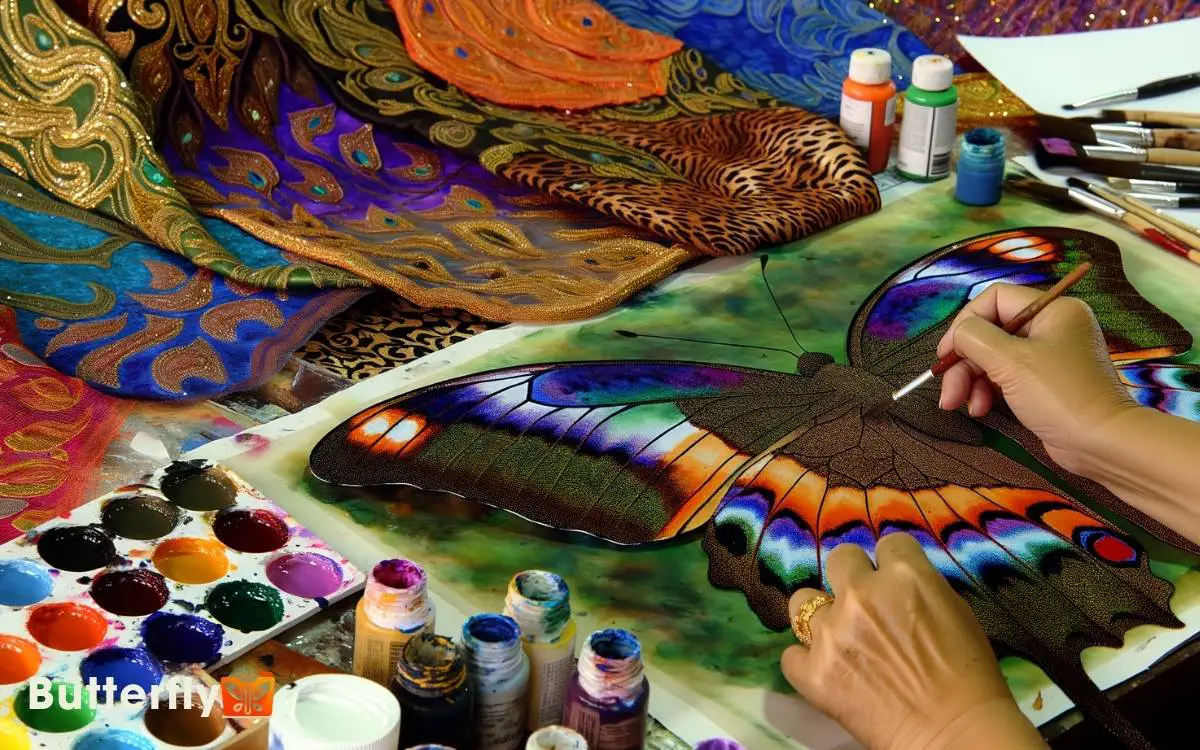How To Make A Butterfly Wing? DIY Instructions!
To craft butterfly wings, gather lightweight wire, colored tissue paper, precision scissors, and PVA glue. Begin by studying real butterfly wings to design a symmetrical template showcasing natural patterns.
Cut the tissue paper using fabric clips and a rotary cutter for accuracy. Shape 20-24 gauge wire to match the contours of the wings, ensuring flexibility and strength. Secure the wire with hot glue, then decorate using vibrant, lightweight materials.
Affix adjustable straps using high-strength adhesives or stitching for comfort and durability. Mastering these steps will guide you to create realistic and functional butterfly wings. Discover more intricate techniques ahead.

Key Takeaways
Gather Your Materials
To begin crafting a butterfly wing, you’ll need specific materials: a lightweight wire, colored tissue paper, scissors, glue, and a template for the wing shape. Start by shaping the lightweight wire to match the template for the wing shape, ensuring it forms a sturdy frame. Next, carefully cut the colored tissue paper to fit the wire frame and glue it in place, allowing it to dry completely. If you’re looking for more details on how to make butterfly wings, consider adding decorative elements like glitter or markers for extra flair.
First, opt for lightweight wire, such as aluminum, which offers both flexibility and structural integrity. Colored tissue paper should be vibrant yet thin to mimic the delicate texture of real wings.
Precision scissors are essential for cutting intricate shapes without fraying the paper. Use a high-quality adhesive, like PVA glue, to guarantee a strong bond between the tissue paper and wire.
Finally, a scientifically accurate template will guide your design, ensuring symmetry and proportionality.
Gathering these materials meticulously will establish a solid foundation for creating innovative, lifelike butterfly wings.
Design the Wing Shape
To design the wing shape, you should start by studying real butterfly wings to understand their natural forms and structures.
Focus on choosing symmetrical patterns, as symmetry is a key characteristic in butterfly wings.
Study Real Butterfly Wings
By closely examining real butterfly wings, you’ll gain invaluable insights into the intricate patterns and complex structures necessary to accurately design the wing shape.
Start by observing the venation, the network of veins that provide structural integrity and facilitate movement. Note the variations in vein thickness and their intersections, as these details are essential for maintaining the wing’s robustness and flexibility.
Analyze the wing’s edge contours, including the scalloped patterns and curvature, which affect aerodynamic properties. Use high-resolution imaging tools to capture microscopic scales that contribute to the wing’s optical effects.
Choose Symmetrical Patterns
When designing the wing shape, start by selecting symmetrical patterns that will guarantee both aesthetic appeal and aerodynamic efficiency. Symmetry guarantees balanced forces during flight, minimizing turbulence and enhancing stability.
Analyze natural butterfly wings using high-resolution images or 3D scans to identify recurring symmetrical motifs.
Focus on mirror-image symmetry along a central axis, as this is crucial for peak performance. Use software like CAD to model these patterns digitally, allowing for precise adjustments.
Incorporate fractal geometry principles to create complex yet harmonious designs.
Remember, the leading edge should be streamlined to reduce drag, while the trailing edge can exhibit elegant curves for improved lift. This meticulous approach will yield a wing both functional and visually striking.
Draw and Refine Shape
Start by sketching the initial outline of the wing, ensuring that the dimensions align with the studied symmetrical patterns and aerodynamic principles. Use a fine graphite pencil for precision. Begin with a central axis to maintain symmetry.
Draw the forewing and hindwing, connecting them smoothly at the thorax junction. Focus on the curvature and tapering edges, optimizing for lift and reduced drag.
Refine the shape by iterating through several drafts. Utilize a lightbox to overlay sketches and make incremental adjustments. Incorporate venation patterns that balance structural integrity and flexibility.
Pay attention to the leading edge; it should be slightly thicker to enhance airflow control. Evaluate your design against biological references and computational fluid dynamics models to achieve an innovative, functional wing shape.
Cut Out the Fabric
Precision is paramount as you carefully lay out the fabric, ensuring it aligns perfectly with the butterfly wing pattern. Use fabric clips to hold the material in place. Employ a rotary cutter for clean, precise edges; scissors can cause fraying.
Keep the fabric taut but not overstretched to maintain its integrity. When cutting, follow the contours of the pattern meticulously.
| Tool | Purpose |
|---|---|
| Fabric Clips | Secure fabric without shifting |
| Rotary Cutter | Achieve clean, precise edges |
| Cutting Mat | Protect surface and extend blade life |
Inspect each cut segment for consistency. Any deviations can compromise the wing’s aerodynamic performance.
Double-check for symmetry and make fine adjustments as necessary. Your careful attention to detail now will result in a structurally sound and visually stunning butterfly wing.
Add Wire for Structure
To add structure to your butterfly wing, you’ll need to select an appropriate wire gauge, typically between 20 and 24 for adequate flexibility and strength.
Next, carefully secure the wire to the fabric using hot glue or stitching, ensuring even distribution to maintain the wing’s shape.
This combination of wire and fabric will create a realistic and durable butterfly wing.
Choose Appropriate Wire Gauge
When selecting the appropriate wire gauge for your butterfly wing structure, consider both the strength needed to support the wing shape and the flexibility required for intricate detailing. A wire gauge between 20 and 24 is typically ideal.
The lower the gauge, the thicker and stronger the wire, providing stability. Conversely, a higher gauge offers greater flexibility, allowing for more precise curve creation.
Use a 20-gauge wire for the main structural lines to guarantee robustness. For finer details, switch to a 24-gauge wire, which grants you the maneuverability essential for delicate patterns.
Always use a high-quality, corrosion-resistant wire, like stainless steel or coated copper, to secure durability and longevity in your innovative butterfly wing design.
Secure Wire to Fabric
Begin by aligning the wire along the edges of the fabric, making sure each segment is securely attached using a strong adhesive or hand-stitching for optimal structural integrity.
Use a wire gauge that balances flexibility and strength, such as 20-gauge steel or aluminum. Before securing, shape the wire to match the contours of the wing.
Apply a thin, even layer of industrial-strength adhesive along the wire, pressing firmly onto the fabric to form a bond.
Alternatively, hand-stitch the wire using a durable thread, following a consistent looping pattern to avoid gaps. Make sure the wire remains taut throughout the process to maintain the wing’s shape.
This method allows for enhanced durability and precision, important for innovative designs.
Decorate the Wings
Carefully select vibrant, lightweight materials for the wing decorations to guarantee both aesthetic appeal and aerodynamic efficiency. Opt for iridescent cellophane, metallic foils, or even thermochromic paint for dynamic color shifts.
Utilize precision cutting tools to create intricate patterns mimicking natural butterfly wing venation. Employ adhesive spray for even application, ensuring minimal weight addition.
Integrate micro-LEDs or electroluminescent wires to accentuate the design and add a luminescent quality.
For a bio-inspired touch, consider adding photovoltaic cells to harness solar energy, powering the LEDs. This approach not only enhances visual appeal but also promotes sustainable energy use.
Make sure all decorations are securely attached to maintain structural integrity during movement.
Attach Straps or Handles
For the butterfly wings to be wearable and functional, securely affix adjustable straps or ergonomic handles using high-strength adhesives or stitching methods.
First, measure and cut straps to fit comfortably around your shoulders or arms. Use nylon webbing for its durability and lightweight properties.
Next, position the straps on the wing frame’s central support, ensuring even weight distribution. Apply industrial-grade adhesive, such as epoxy resin, to bond the straps to the frame.
For added security, reinforce the connection with a robust zigzag stitch using a heavy-duty sewing machine.
If using handles, opt for ergonomic designs to reduce strain. Attach these handles firmly with screws or rivets, ensuring they can withstand repeated use and movement.
Conclusion
You’ve now created butterfly wings that could make even the real ones jealous!
With your materials gathered, wing shape designed, fabric cut, wire added for structure, and decorations lovingly applied, you’ve mastered the art of wing crafting.
Finally, attaching straps or handles secures they’re wearable and ready for flight.
Your meticulous attention to detail and precision has paid off, resulting in a stunning, scientifically-engineered masterpiece.
Go ahead, spread your wings and let your creativity soar!






